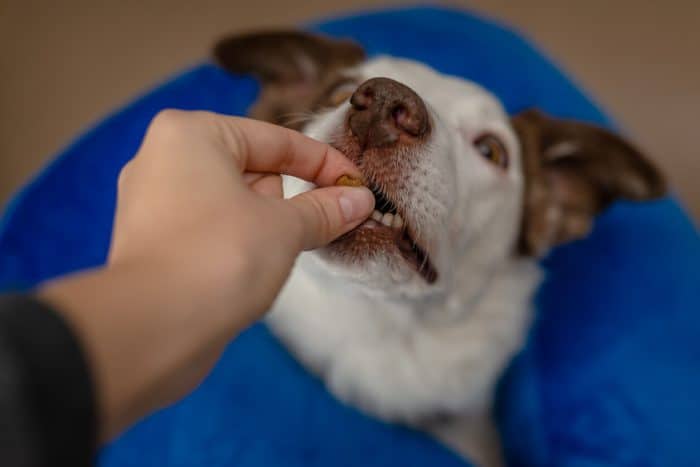- Not a substitute for professional veterinary help.
Loratadine, also known by the brand name Claritin, is an antihistamine medication that can treat allergy symptoms. This medication was designed for humans, but in some cases, you can also give your dog loratadine—with approval from a veterinarian.
While loratadine can help treat allergic reactions in dogs, not all forms of loratadine are safe for dogs. What’s more, it’s also possible to give your dog too much. You’ll want to use caution when giving your dog over-the-counter medication, especially medication meant for people.
It’s important to always ask a vet first before giving your dog a new medication. Read on to learn everything you need to know about giving your dog loratadine (Claritin) for allergies.
What Is Loratadine?
Loratadine blocks the effects of a chemical called histamine.
Histamine is part of your dog’s immune system. When your dog encounters an allergen, histamine alerts the body’s alarm system and triggers the main defense mechanism: inflammation.
Blood carrying white blood cells rushes to the area, causing swelling. The glands in your dog’s nose and eyes then produce more snot and tears. The nerves in their skin start sending itch signals to their brain.
Allergy treatments like Loratadine and Benadryl—another dog-friendly antihistamine—basically stand in front of the alarm and tell the histamine to stop overreacting. Once histamine can’t act anymore, the inflammation gradually stops, and your dog’s symptoms should disappear too.
Can Loratadine Help Treat Dog Allergies?
Histamine isn’t as big of a player in a dog’s immune system as it is in yours. Thus, loratadine may not do quite as much to improve your dog’s seasonal allergies.
For some dogs and cats that have really severe itchy allergic skin disease, loratadine may make up part of a treatment plan to try and ease discomfort, says Dr. Zac Pilossoph, consulting veterinarian at Healthy Paws Pet Insurance. However, he says vets rarely use this as a standalone treatment for chronic allergies.
Vets may, however, recommend loratadine to address short-term allergic reactions. Many things can cause allergic reactions in dogs, including skin irritants, tick bites, bee stings, and vaccines. Loratadine can offer relief for the resulting symptoms, such as:
- Itching
- Swelling
- Skin redness
- Hives
This medication can act quickly, improving symptoms in as little as 10 minutes.
Test tube studies also suggest loratadine could also help dogs with mast cell tumors. Cancerous mast cells can produce high levels of histamine, causing many of the same symptoms as allergies. Loratadine may help block excess histamine and slow the tumor’s growth. That said, more research is needed before this treatment becomes widely used.
Is Loratadine Safe For All Dogs?
Because so little research has explored this medication’s safety for dogs, it’s important to use care when giving it to high-risk pets.
“Pregnant dogs should not be given medications without consulting a vet, as it could potentially harm the unborn puppies,” says Dr. Andrea Johnston, a board-certified small animal veterinary internist and medical board member at The Vets.
Loratadine can also interact with other medications your dog takes, increasing the risk of side effects. Medications loratadine can interact with include:
- Cimetidine, an antacid
- Erythromycin, an antibiotic
- Ketoconazole, an antifungal medication
- Omeprazole, a proton-pump inhibitor
Dogs who have liver or kidney disease may also have trouble metabolizing loratadine. Your vet can offer more guidance on whether your dog can safely take this medication.
Loratadine Products To Avoid Giving Dogs
“While Loratadine itself is generally safe for dogs, some Claritin products may contain additional ingredients that could be harmful,” Dr. Johnston says.
For example, Claritin-D contains a decongestant called pseudoephedrine. In humans, pseudoephedrine helps clear up nasal congestion. But in dogs, it could cause vomiting, tremors, hyperactivity, and drooling. These symptoms typically develop within 30-60 minutes of your dog ingesting the medication.
Fast-dissolving tablets may also contain sweeteners that are toxic for dogs. None of Claritin’s current products contain the most dangerous sweetener, xylitol. However, flavored Claritin chewables do contain aspartame, which can give some dogs an upset stomach.
What’s The Recommended Loratadine Dosage For Dogs?
“There is limited information about administering Loratadine in dogs, and most of it is anecdotal,” Dr. Johnston says.
The appropriate dosage depends on a lot of factors, including:
- Size
- Weight
- Age
- Allergy symptoms
- Overall health
According to Fairhaven Animal Hospital, a healthy, 40-pound dog may be able to handle a 10 milligram dose of Claritin. A small dog will likely only be able to tolerate a fraction of that.
Since so many variables can play a role in the correct dosage, it’s always best to have your vet help find the right dose of loratadine for your dog.
Risks And Side Effects Of Loratadine For Dogs
Most side effects people report from this medication are mild and may include dry mouth, dry eye, and headaches. Generally, pets don’t seem to experience these, Dr. Pilossoph says.
However, both Dr. Pilossoph and Dr. Johnston say your dog can experience side effects if they take too much loratadine. Symptoms to pay attention to include:
- Agitation
- Rapid heart rate
- Vomiting
While Loratadine usually doesn’t cause drowsiness by itself, some drug interactions can make your dog groggy instead of excitable.
Generally speaking, dogs can take loratadine once or twice a day, with or without food. But before you give them any medication, you’ll want to ask your vet. They can tell you how to safely and effectively add allergy medication to your dog’s allergy treatment plan.
At the end of the day, dogs don’t always benefit from the same medications people do. Here’s some more reading on giving human medication to dogs:




